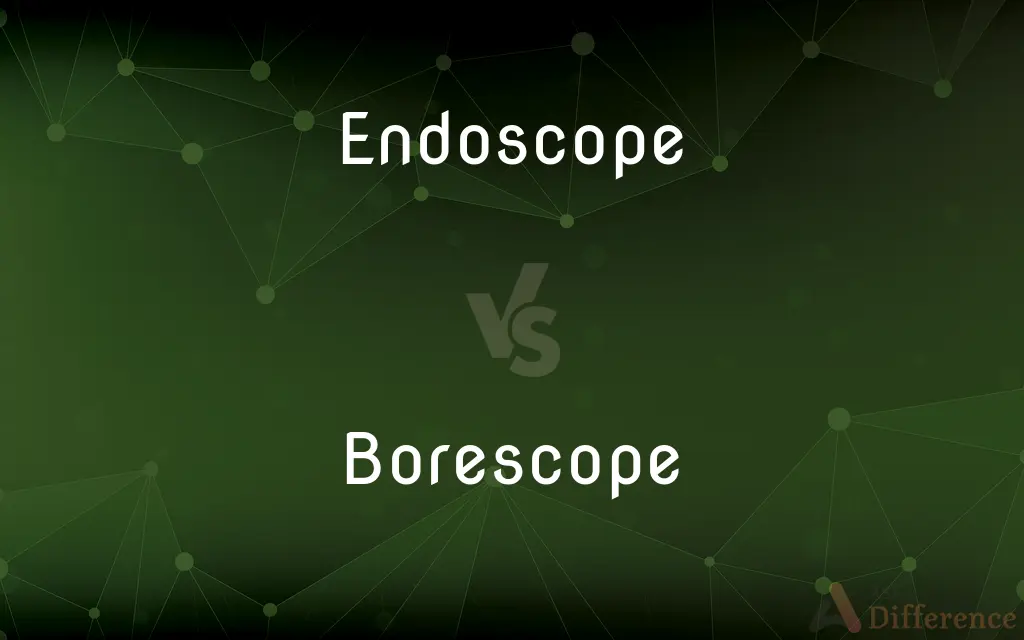Endoscope vs. Borescope — What's the Difference?
By Tayyaba Rehman & Urooj Arif — Updated on April 22, 2024
An endoscope is used primarily in medical procedures to view inside the body, while a borescope is used in mechanical and engineering fields to inspect machinery interiors.

Difference Between Endoscope and Borescope
Table of Contents
ADVERTISEMENT
Key Differences
Endoscopes are designed with flexibility to navigate the human body’s complex pathways, equipped with features like lighting and channels for tools. In contrast, borescopes often have a rigid or semi-rigid tube, making them suitable for inspecting non-organic structures.
While endoscopes are critical for diagnostic and surgical procedures within medical fields, borescopes are utilized for maintenance and inspection tasks in various industries such as aviation, automotive, and manufacturing.
Endoscopic equipment usually includes capabilities for tissue removal and fluid management to aid medical procedures, whereas borescopes may feature attachments like mirrors and magnets to facilitate mechanical repairs.
The use of endoscopes is governed by stringent sterilization and bio-compatibility standards due to their invasive nature. On the other hand, borescopes do not require such rigorous sanitation as they are not designed for contact with sensitive or sterile environments.
Image quality and flexibility are paramount in endoscopes to provide clear, accurate visuals of the body's internal structures. Meanwhile, borescopes prioritize durability and access to narrow or challenging mechanical spaces.
ADVERTISEMENT
Comparison Chart
Primary Use
Medical procedures
Mechanical and engineering inspections
Flexibility
Highly flexible, some are rigid
Rigid or semi-rigid
Attachments
Biopsy tools, snares
Mirrors, magnets
Sanitation Standards
High, requires sterilization
Lower, no need for sterilization
Image Quality
High, critical for diagnosis
Moderate, sufficient for inspection tasks
Compare with Definitions
Endoscope
A tool equipped with a camera and light to facilitate minimally invasive surgeries.
Surgeons used an endoscope to remove the gallbladder.
Borescope
Often comes with a rigid or semi-rigid tube to access hard-to-reach areas.
The mechanic used a borescope to inspect the car's cylinder.
Endoscope
May carry instruments for procedures like biopsy or polyp removal.
The endoscope enabled tissue sampling without major surgery.
Borescope
An optical device used for the visual inspection of machinery interiors.
A borescope examined the aircraft engine for cracks.
Endoscope
Requires strict sterilization to prevent infections.
The endoscope was sterilized thoroughly before the procedure.
Borescope
May include features like LED lighting and video capabilities.
The borescope’s camera captured clear images of the inside of the pipeline.
Endoscope
A medical instrument used for viewing the interior of a hollow organ or body cavity.
An endoscope was used to investigate the patient's stomach discomfort.
Borescope
Utilized in various industries for maintenance and troubleshooting.
The borescope detected the blockage in the industrial pump.
Endoscope
Often flexible to navigate through winding pathways within the human body.
The doctor maneuvered the endoscope through the colon.
Borescope
Does not require sterilization, unlike medical scopes.
The borescope was cleaned with standard industrial solvents.
Endoscope
An endoscope is an illuminated optical, typically slender and tubular instrument (a type of borescope) used to look deep into the body and used in procedures called an endoscopy. Endoscopes use tubes which are only a few millimeters thick to transfer illumination in one direction and high-resolution images in real time in the other direction, resulting in minimally invasive surgeries.
Borescope
A borescope (occasionally called a boroscope, though this spelling is nonstandard) is an optical instrument designed to assist visual inspection of narrow, difficult-to-reach cavities, consisting of a rigid or flexible tube with an eyepiece or display on one end, an objective lens or camera on the other, linked together by an optical or electrical system in between. The optical system in some instances is accompanied by (typically fiberoptic) illumination to enhance brightness and contrast.
Endoscope
A slender, tubular instrument, such as an arthroscope or laparoscope, that is inserted into a body cavity or part for the purpose of visual examination, diagnosis, or surgical treatment.
Borescope
An optical instrument used for seeing inside tight spaces, consisting of a rigid or flexible tube with an optical relay inside so that the view through a lens or window at one end of the tube may be seen from a lens or eyepiece in the opposite end of the tube.
Endoscope
An instrument used to examine a bodily orifice or canal, or a hollow organ.
Endoscope
An instrument for examining the interior of the body, consisting of a flexible tube with lenses and optical fibers permitting illumination of the interior site to be inspected, and visualization of the interior site from outside the body; it often has small surgical instruments attached to the end and manipulable from the outside, permitting biopsy or surgery. It is used as a non-invasive or minimally invasive tool for diagnosis or treatment, especially in organs having an external opening such as the rectum, the urethra, and the bladder.
Endoscope
A long slender medical instrument for examining the interior of a bodily organ or performing minor surgery
Common Curiosities
How is a borescope different from an endoscope?
A borescope is less flexible and not used in medical settings.
Are borescopes inserted into the human body?
No, they are intended for mechanical inspections.
How do endoscopes enhance medical procedures?
They allow for less invasive surgeries and diagnostics.
What additional features do borescopes have?
Some have attachments like mirrors to view different angles.
What is an endoscope used for?
It is used for medical examinations and surgeries inside the body.
How are endoscopes and borescopes cleaned?
Endoscopes require sterilization, while borescopes usually just need general cleaning.
What is the main benefit of using a borescope in industry?
It allows for the inspection of inaccessible areas without disassembly.
Can an endoscope be used in engineering?
No, endoscopes are specifically designed for medical use.
Are there different types of endoscopes?
Yes, including flexible and rigid types, depending on the application.
Do borescopes have any medical applications?
Generally no, they are tailored for technical and industrial use.
What industries use borescopes?
Aviation, automotive, and manufacturing among others.
Can borescopes record video?
Yes, many modern borescopes are equipped with video recording capabilities.
Is image quality important for both devices?
Yes, but it is critical for endoscopes due to their diagnostic purposes.
What types of procedures are performed with an endoscope?
Biopsies, exploratory surgeries, and polyp removals.
How does the flexibility of an endoscope benefit its use?
It allows navigation through tight and curved spaces within the body.
Share Your Discovery

Previous Comparison
Foetus vs. Fetus
Next Comparison
City vs. RegionAuthor Spotlight
Written by
Tayyaba RehmanTayyaba Rehman is a distinguished writer, currently serving as a primary contributor to askdifference.com. As a researcher in semantics and etymology, Tayyaba's passion for the complexity of languages and their distinctions has found a perfect home on the platform. Tayyaba delves into the intricacies of language, distinguishing between commonly confused words and phrases, thereby providing clarity for readers worldwide.
Co-written by
Urooj ArifUrooj is a skilled content writer at Ask Difference, known for her exceptional ability to simplify complex topics into engaging and informative content. With a passion for research and a flair for clear, concise writing, she consistently delivers articles that resonate with our diverse audience.
















































